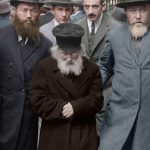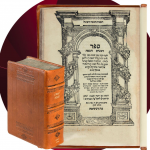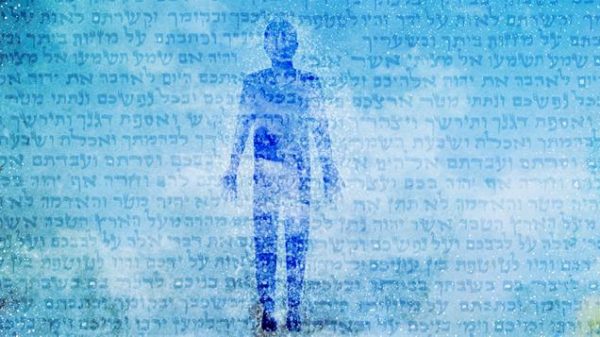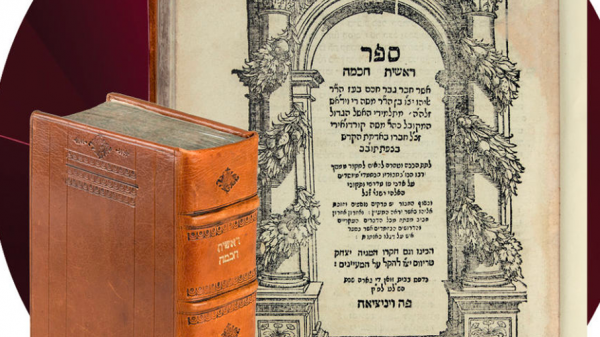Click here to download PDF
He was worried about a Traffic Jam?!?
“And Yaakov dwelled…” Rashi brings a Midrash: “This flax dealer came in to town with all his [many] camels laden with flax. The blacksmith wonders where will all this flax will fit. A wise man answered him: ‘one spark comes out from your bellows that will burn it all’. So also, Yaakov saw the chiefs of Eisov written above (in Vayishlach) and wondered ‘who can conquer them all?’ What’s written further on? ‘These are the descendants of Yaakov – Yosef and it is written ‘and the house of Yaakov will be fire and the house of Yosef flame and the house of Eisov will be straw (Ovadia 1:18) a spark comes out from Yosef that burns them all.”
This Midrash needs explaining. First and foremost, the metaphor of the Midrash seems to make light of the situation. In the metaphor the blacksmith is worried about a ‘traffic jam’ while Yaakov seemingly fears for his survival! Why do the Sparks have come from the bellows that blows on the flame? Why does it need to be a ‘spark that shoots out’? He could just take fire on a stick and torch the flax! If Yaakov himself is likened to fire then who needs Yosef to ‘burn up the flax’ that represents Eisov? How can Yaakov seriously be concerned for his survival and need to be informed about the power of Yosef? He himself wrestled Eisov’s angel and defeated him and regarding Yosef’s special power to take down Eisov, Yaakov knew that already! That’s what prompted him to have the confidence to leave the house of Lavan and go back to the land of Israel and that’s why he asked Lavan to leave after the birth of Yosef (30:25 Rashi).
Fire & Sparks
The Navi (Yirmiyahu 23:29) says: “For my words are like fire says Hashem and like a hammer shatters Stone” the latter part of the Pasuk of “hammer shatters stone” is explained by Chazal as “making Sparks”. The same D’Bei Rabi Yishmael interpret this Pasuk in three different ways in three different places in the Gemara. In Shabbos (88b) D’Bei Rabi Yishmael interprets the second part of the Pasuk “like Hammer shatters stone” as:”.. just like this Hammer causes a division into many Sparks so also every utterance that came out of ‘Hashem’s mouth’ subdivided into all the 70 languages.” According to this the ‘fire’ is the Torah itself and the ‘Sparks’ is the how it subdivided into 70 languages. For what purpose did it subdivide into 70 languages? In Sanhedrin (34A) the same D’Bei Rabi Yishmael interprets “like a hammer shatters Stone” as: “just like the hammer smashes into multiple Sparks so also one pasuk could splinter into different reasonings”. The same D’Bei Rabi Yishmael says a totally different drasha on this Pasuk in Kidushin (30b) “for my words are like fire” refers to the Torah. “If a person is tempted by the Yetzer Harah just like a hammer shatters stone so also if the Yetzer Harah is hard like iron it will explode and if it is hard like stone it will melt because Torah is also compared to water, and water gradually dissolves Stone”. How can we reconcile these three different interpretations as they come from the same D’Bei Rabi Yishmael?
Sparks
All these different “drashos” are different ‘Sparks’ of the same idea: the relationship of the “Torah shebichtav”-the written law to the “Torah shebaal peh” -the oral Torah. The “Torah shebichtav” is undoubtably the primary source that everything is based on. It is the words of Hashem that are “fire”, but a fire does not necessarily have to glow. A coal could have fire in it and be very hot without glowing but when you blow on it, it flares up and glows. To the extent that the flame is exposed by the blowing so also different colors can be seen. All the lights, colors and Sparks were hidden within the coal and through the blowing all becomes revealed and subdivides into separate Sparks and colors. With this, the Ramchal, in his essay Derech Etz Chaim, explains why the words of Chazal are called “coals of fire” or what Ben Bag Bag said: “turn it (Torah) over and turn it over for everything is in it”. Fire does not necessarily have to shine bright and show all its colors, but with “turning it over” like “raking up the coals” you could see all that’s encoded in it. That’s why the words of Chazal are ”coals of fire” – there’s so much light and color hidden within their words, but you just have to “blow on them” to see it. The Ramchal goes on to explain: “For Hashem has given wisdom (past tense) and from His Mouth is knowledge and understanding (present tense)”. The wisdom of Torah is already given, but to have new knowledge and understanding is from “His Mouth”. Hashem “blows” on the coals of the Torah together with you when you “blow” on them. The way we “blow” on them is by toiling which activates our “Neshama”-soul which was created by Hashem’s “Nishmas chaim” -Breath of life. We put our “Neshama” into our learning by “raking up the learning” with intensity and cross-analysis. By activating the “Neshama” which is the “Divine breath from Hashem’s Mouth” that “Sparks” our understanding to see new “knowledge and understanding” in Torah beyond the ever present black on white of the words. The first and primary expression of the power of the “Neshama” in the body is speech. When we speak the words of Torah we’ve already started activating the power of the “Neshama” the Divine breath to blow on the fire of Torah to make it shine bright with new sparks of understandings, that’ s also another reason why it’s called “Torah shebaal peh” – the Oral law as the power of the “Neshama” which is the Divine breath that makes speech is deployed.
Torah shebichtav & Torah shebaal peh
With this we understand D’Bei Rabi Yishmael in Sanhedrin. The “Sparks” are the different reasonings like the different opinions of Beis Shammai and Beis Hillel. It’s a model to understand how two different divergent understandings could come from the same pasuk. It’s like the flame that comes out from the coal could spark in different directions and give off different colors! D’Bei Rabi Yishmael in Shabbos is actually adding another layer of depth and understanding to this. It was and remains the Divine intent that Torah indeed splinter into different understandings. By Sinai the “words of Hashem” splintered into 70 different languages. Every language has its own unique nuances. Some things could better be described in certain languages than others. Every culture has their particular mentality that makes them distinct from other cultures and have their own language to match! “Torah shebaal peh” actually expanded in exile. Every place we went and encountered foreign languages and cultures chiddushei Torah were formulated in response and often even expressed in the languages of those host countries. The different ways of learning and serving Hashem emerged in the different Kehilos set up in course of our many years in the diaspora. It is by Divine intent that Torah “spark” into different understandings, particularly in exile! When challenged by alien cultures there will always be a response to those challenges from the host countries and that’s the secret that the Torah was said in 70 languages.
Torah Shebaal peh vanquishes Evil
With these two statements of D’Bei Rabi Yishmael in mind let’s revisit their statement in Kiddushin. The full quote is: “They learned in D’Bei Rabi Yishmael my son if you’ll be confronted by the Yetzer Harah pull him to the Beis Medrash if he is like Stone he will melt and if he is like iron he will explode as it says, “my words like fire says Hashem and like a hammer shatters Stone”. D’Bei Rabi Yishmael are saying take him to the Beis Medrash where Torah shebaal peh is learnt! The aspect of Torah that vanquishes the Yetzer Hara that afflicts us is the Torah shebaal peh. The Yetzer Harah is our personal problem that follows us everywhere and is very much a part of us. The only answer is to find our personal connection to the Torah – our unique spark and color! The personal connection to the Torah is what’s necessary for the Torah to have the healing effect to explode our Yetzer Harah and melt our heart of Stone. This means it is the Torah shebaal peh that vanquishes evil.
Yaakov vs Yosef
Yaakov’s attribute of “Tiferes” is the level of Torah (See this year’s Even Shesiya on Vayetzeh). But to be more precise: “Tiferes” is the level of the written Torah. Yosef by comparison is the Torah shebaal peh. Yaakov and Yosef parallels in their lives and Yosef very much resembled Yaakov. Yosef is a “branch out” (or “spark”) in the sense that relative to his brothers is also an of a patriarch because his own two children, Menashe and Ephraim were equally tribes just like Reuven and Shimon. Of course, relative to Yaakov, Yosef is a tribe. Yosef is a “branch out” from “Av” to “Shevet”. The role Yosef played in his generation was the original branching out of the Jewish people to “tribes” and beyond the confines of Yaakov’s sphere of influence. He went into the exile and sanctified Hashem’s Name amongst Egyptians. The power of Torah shebaal peh to “spark out” is not just for the glorification of Torah it’s also the secret of our ability to thrive amongst the Goyim and to respond with Chiddushei Torah to all the challenges that they throw at us. Yosef’s name actually means “to add” as the Torah shebaal peh adds “Sparks” and “colors” that were previously hidden and encoded in Torah shebichtav (Yaakov). Yosef extends the fire of Yaakov. That’s what the Navi means: “the house of Yaakov is fire and the house of Yosef is flame”: fire does not necessarily need to be bright, flame is what shines bright with all the different colors. As Chazal tell us regarding this pasuk: “a fire without flame does not go far”! The flame is what travels with the wind and Yosef is the “flame” that Sparks colors in all different directions – far and wide.
Infowars
Yaakov was not concerned about survival. He knew he was capable, he knew Hashem will protect him, and he was already aware of Yosef’s unique abilities to take down Eisov. This was a war to conquer public opinion! The blacksmith operates within the confines of his own shop, so also “Yaakov wanted to sit in tranquility” and avoid the stress of converting the outside world to the Torah’s truth. He sees all the straw filling up the whole public domain which means: he saw how Eisov was conquering World opinion! Rashi draws the parallel from the metaphor to real life as Yaakov wondering who can conquer all of them? He wasn’t worried about survival, he was wondering how to liberate world opinion from them. The wise man tells him from your “bellows” which is the breath that makes the sparks of Torah shebaal Peh will come the spark which is Yosef! Straw cannot hold up to a spark, so also “Fake news” Cannot hold up against truth. Eventually people will see the difference, and that’s the power of Yosef and Torah shebaal peh! It’s not just about surviving in exile, it is the power to influence public opinion! In every society we were exiled to, we had an effect on that culture that prepared it for its eventual conversion to the Torah perspective. At Sinai the Dibros “sparked” into every single language because the Torah is meant to influence all the cultures on Earth! We create that influence with the Torah shebaal peh we create in those cultures and by speaking divrei Torah in the language of the host country.
10th Of Teves vs Chanukah
Prior to the story of Hanukkah there was another encounter with the gentile world that did not end well (yet). It was with the Egyptian Greeks. King Ptolemy forced 70 zekainim to translate the Torah for him. He only wanted the written law and we were not going to volunteer to give him our precious Torah shebaal peh. That’s why they had to make changes in the Torah because there was no way Ptolemy could understand it if it would been translated literally and without Torah shebaal peh. We suffered greatly as that’s how the “Bible” got into the hands of the Gentiles and that was the basis for Christianity and Islam. Because of this blurring of the boundaries, that our written law went out to the Gentiles, that’s what created the cosmic damage so that some years later the Syrian Greeks were able to break into our boundaries, break into the Beis Hamikdash, put their paganism there, and try to impose their culture upon us. That’s the secret that the Syrian Greeks made 13 breaches in the walls around the Beis Hamikdash- they made a breach in for every change the zekainim made when the Torah went out!! The “Tikun” for the situation was Chanukah which is a holiday of Torah shebaal peh. The whole story happens after we no longer had Prophets. The Torah shebaal peh is represented by the light of the menorah candles. As the pasuk says: “The candle of Hashem is “Nishmas”-soul of a person” The Neshama which is the vehicle of the Torah shebaal peh that comes from the “Divine Breath” – that is what’s represented by the candles of the menorah. That’s how we defeated the Greeks! When the Greeks were driven out we did not suffice with just reestablishing the boundaries between the holy and the profane, repairing the breaches around the Beis Hamikdash, and securing our borders. We took it one step further and have the light of the menorah shine outside to the public domain. The power of Torah shebaal peh, represented by the Menorah, is not just to survive against alien cultures but also to gradually convert them to the light of our way of thinking – to conquer the whole world for the kingdom of Hashem.








